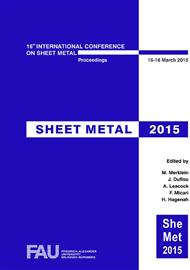p.369
p.377
p.385
p.395
p.403
p.411
p.419
p.427
p.435
Experimental and Numerical Investigation on a Pressure Dependent Friction Model
Abstract:
The objective of this paper is the investigation of the implemented pressure dependent friction model in the FE simulation program AutoForm. Since the values for the required parameters of this approach are not defined in the actual FE simulation program, this paper contributes to a first definition of these parameters. Therefore, experimental investigations with the cup drawing tests are carried out. With the support of the experimental results regarding the maximum stamping force, the model is calibrated and subsequently validated by the comparison of the sheet thicknesses of the experimental and numerical investigations. The results of this validation reveal a good accordance of simulation and reality in nearly all areas. However there are also areas in which the prediction accuracy decreases in comparison to the basic simulation. Therefore, additional investigations have to be carried out which concentrate on the modification of this pressure dependent approach towards a better universal prediction accuracy of the simulation.
Info:
Periodical:
Pages:
403-410
Citation:
Online since:
March 2015
Authors:
Keywords:
Price:
Сopyright:
© 2015 Trans Tech Publications Ltd. All Rights Reserved
Share:
Citation:


